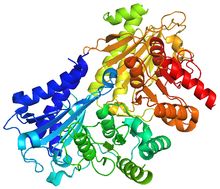Sedoheptulose-bisphosphatase
| sedoheptulose-bisphosphatase | |||||||||
|---|---|---|---|---|---|---|---|---|---|

Crystallographic structure of sedoheptulose-bisphosphatase from Toxoplasma gondii
|
|||||||||
| Identifiers | |||||||||
| EC number | 3.1.3.37 | ||||||||
| CAS number | 9055-32-7 | ||||||||
| Databases | |||||||||
| IntEnz | IntEnz view | ||||||||
| BRENDA | BRENDA entry | ||||||||
| ExPASy | NiceZyme view | ||||||||
| KEGG | KEGG entry | ||||||||
| MetaCyc | metabolic pathway | ||||||||
| PRIAM | profile | ||||||||
| PDB structures | RCSB PDB PDBe PDBsum | ||||||||
| Gene Ontology | AmiGO / EGO | ||||||||
|
|||||||||
| Search | |
|---|---|
| PMC | articles |
| PubMed | articles |
| NCBI | proteins |
Sedoheptulose-bisphosphatase (also sedoheptulose-1,7-bisphosphatase or SBPase) (EC 3.1.3.37) is an enzyme that catalyzes the removal of a phosphate group from sedoheptulose 1,7-bisphosphate to produce sedoheptulose 7-phosphate. SBPase is an example of a phosphatase, or, more generally, a hydrolase. This enzyme participates in the Calvin cycle.
SBPase is a homodimeric protein, meaning that it is made up of two identical subunits. The size of this protein varies between species, but is about 92,000 Da (two 46,000 Da subunits) in cucumber plant leaves. The key functional domain controlling SBPase function involves a disulfide bond between two cysteine residues. Additionally, SBPase requires the presence of magnesium (Mg2+) to be functionally active. SBPase is bound to the stroma-facing side of the thylakoid membrane in the chloroplast in a plant. Some studies have suggested the SBPase may be part of a large (900 kDa) multi-enzyme complex along with a number of other photosynthetic enzymes.
SBPase is involved in the regeneration of 5-carbon sugars during the Calvin cycle. Although SBPase has not been emphasized as an important control point in the Calvin cycle historically, it plays a large part in controlling the flux of carbon through the Calvin cycle. Additionally, SBPase activity has been found to have a strong correlation with the amount of photosynthetic carbon fixation. Like many Calvin cycle enzymes, SBPase is activated in the presence of light through a ferredoxin/thioredoxin system. In the light reactions of photosynthesis, light energy powers the transport of electrons to eventually reduce ferredoxin. The enzyme ferredoxin-thioredoxin reductase uses reduced ferredoxin to reduce thioredoxin from the disulfide form to the dithiol. Finally, the reduced thioredoxin is used to reduced a cysteine-cysteine disulfide bond in SBPase to a dithiol, which converts the SBPase into its active form.
...
Wikipedia
